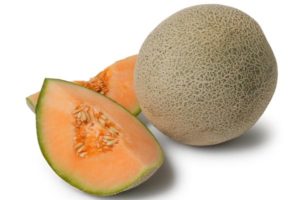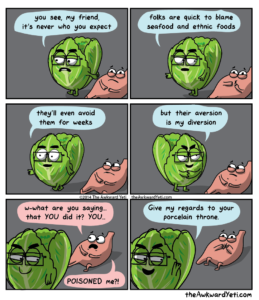Contrary to what Australians are being told, cantaloupe – er, rockmelon – is a known source of foodborne illness and many scientists have investigated the many ways nasty bacteria get on or in the melon; along with potential treatments.
 In this paper, researchers from the U.S. Department of Agriculture report surface structure and biochemical characteristics of bacteria and produce play a major role in how and where bacteria attach, complicating decontamination treatments.
In this paper, researchers from the U.S. Department of Agriculture report surface structure and biochemical characteristics of bacteria and produce play a major role in how and where bacteria attach, complicating decontamination treatments.
Whole cantaloupe rind surfaces were inoculated with Salmonella, Escherichia coli O157:H7, and Listeria monocytogenes at 107 CFU/ml. Average population size of Salmonella, Escherichia coli O157:H7, and L. monocytogenes recovered after surface inoculation was 4.8 ± 0.12, 5.1 ± 0.14, and 3.6 ± 0.13 log CFU/cm2, respectively. Inoculated melons were stored at 5 and 22°C for 7 days before washing treatment interventions. Intervention treatments used were (i) water (H2O) at 22°C, (ii) H2O at 80°C, (iii) 3% hydrogen peroxide (H2O2) at 22°C, and (iv) a combination of 3% H2O2 and H2O at 80°C for 300 s. The strength of pathogen attachment (SR value) at days 0, 3, and 7 of storage was determined, and then the efficacy of the intervention treatments to detach, kill, and reduce transfer of bacteria to fresh-cut pieces during fresh-cut preparation was investigated. Populations of E. coliO157:H7 attached to the rind surface at significantly higher levels (P < 0.05) than Salmonella and L. monocytogenes, but Salmonella exhibited the strongest attachment (SR value) at all days tested. Washing with 3% H2O2 alone led to significant reduction (P < 0.05) of bacteria and caused some changes in bacterial cell morphology. A combination treatment with H2O and 3% H2O2 at 8°C led to an average 4-log reduction of bacterial pathogens, and no bacterial pathogens were detected in fresh-cut pieces prepared from this combination treatment, including enriched fresh-cut samples.
The results of this study indicate that the microbial safety of fresh-cut pieces from treated cantaloupes was improved at day 6 of storage at 5°C and day 3 of storage at 10°C.
Effect of hydrogen peroxide in combination with minimal thermal treatment for reducing bacterial populations on cantaloupe rind surfaces and transfer to fresh cut pieces
01.aug.2016
Ukuku, Dike O.1; Mukhopadhyay, Sudarsan2; Geveke, David2; Olanya, Modesto2; Niemira, Brendan2
1: U.S. Department of Agriculture, Agricultural Research Service, Eastern Regional Research Center, 600 East Mermaid Lane, Wyndmoor, Pennsylvania 19038, USA;, Email: dike.ukuku@ars.usda.gov 2: U.S. Department of Agriculture, Agricultural Research Service, Eastern Regional Research Center, 600 East Mermaid Lane, Wyndmoor, Pennsylvania 19038, USA
Journal of Food Protection, August 2016, Number 8, Pages 1316-1324, DOI: http://dx.doi.org/10.4315/0362-028X.JFP-16-046
http://www.ingentaconnect.com/content/iafp/jfp/2016/00000079/00000008/art00002


